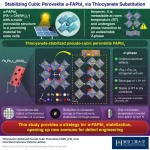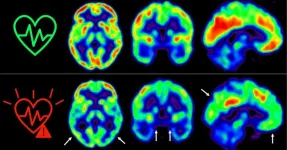(Press-News.org) A new study led by McGill University examines why people living in Atlantic regions are more at-risk for developing melanoma than other Canadians, providing lessons on skin cancer prevention for the whole country.
Rates of melanoma, a deadly form of skin cancer, have been rising globally, including in Canada. Current estimates indicate that up to 1 in 3 Canadians will develop some form of skin cancer during their lifetime. While some Atlantic provinces such as Prince Edward Island (PEI) and Nova Scotia have the highest incidence rate of melanoma in the country, neighbouring provinces like New Brunswick and Newfoundland and Labrador have rates below or comparable to the Canadian average.
To find out why, the researchers compared UV exposure and behaviours among different groups in Atlantic Canada based on income, education, and gender, among other factors.
Higher-income individuals more at risk for melanoma
The study found that higher-income individuals had an increased risk of melanoma. Risk factors contributing to this include more lifetime sun burns, tanning bed use, and being tanned. Similarly, individuals with university education had higher rates of recreational sun exposure but were less likely to use tanning beds.
“A higher socio-economic status is known to be associated with more vacations in sunny climates and recreational tanning, which likely ultimately drives melanoma incidence in this population,” highlights Dr. Ivan Litvinov, an Associate Professor in the Department of Medicine and Chair of the Dermatology Division at McGill University.
However, the study also showed that individuals earning less than $50,000 a year were more likely to work outdoors and experience occupational sun exposure, placing them at a higher risk of developing skin cancer. These findings suggest that policies to protect outdoor workers could help reduce melanoma risk, say the researchers.
Men are more skeptical of sunscreen
Looking at differences between men and women, the researchers found that women had less sun exposure and practiced more sun protection compared to men. Men were more likely to report more lifetime sunburns as well as occupational and recreational sun exposure. They also had higher rates of melanoma and other skin cancers.
Nevertheless, women tended to wear fewer long-sleeve shirts and frequented tanning beds more. These behaviours, the researchers say, may explain findings in a previous study that show women are more likely to develop melanoma in their extremities.
When it comes to skin cancer prevention, their study found that men express more negative beliefs toward sunscreen use than women. Consistent with this, women were more concerned about new moles and were more likely to seek medical advice from a family physician. The researchers say these behavior patterns may account for the overall lower melanoma incidence and mortality in women.
Putting sun protection knowledge into practice
The findings also show that people living in the most high-risk communities of PEI and Nova Scotia had more sunburns and sun exposure compared to people in regions like Newfoundland and Labrador. Surprisingly, those living in these high-risk communities had more knowledge of sun protection and melanoma awareness as well.
“To prevent skin cancer many Canadians really need to act on the knowledge they already have. Applying sunscreen is one of the effective ways to prevent skin cancer,” says Dr. Litvinov.
Public health efforts aimed at reducing skin cancer should be tailored to target specific demographic groups, the researchers say. “You need to have a different sun protection message when you’re talking to a single young man versus a mother of three children,” says Dr. Litvinov.
“Governments also have a direct role to play in combatting rising rates of melanoma. It’s projected that the financial burden of skin cancer to the Canadian healthcare system could rise to one billion annually by 2030,” he adds. “Canada should follow in the footsteps of many countries that have removed sales tax on sunscreen to promote their use.”
About the study
“Assessing Skin Cancer Risk Factors, Sun Safety Behaviors and Melanoma Concern in Atlantic Canada: A Comprehensive Survey Study” by François Lagacé et al. was published in Cancers.
END
Why men, wealthy people and maritime residents are more likely to develop skin cancer
Study compares UV exposure and behaviours among different groups in with the goal of improving public health efforts aimed at reducing melanoma rates
2023-08-31
ELSE PRESS RELEASES FROM THIS DATE:
The search for the super potato
2023-08-31
As climate change continues to pose severe challenges to ensuring sustainable food supplies around the world, scientists from McGill University are looking for ways to improve the resilience and nutritional quality of potatoes. Professor Martina Strömvik and her team have created a potato super pangenome to identify genetic traits that can help produce the next super spud.
“Our super pangenome sheds light on the potato’s genetic diversity and what kinds of genetic traits could potentially be bred into our modern-day crop to make it better,” ...
Better paths yield better AI
2023-08-31
Deep Learning (DL) performs classification tasks using a series of layers. To effectively execute these tasks, local decisions are performed progressively along the layers. But can we perform an all-encompassing decision by choosing the most influential path to the output rather than performing these decisions locally?
In an article published today in Scientific Reports, researchers from Bar-Ilan University in Israel answer this question with a resounding "yes". Pre-existing deep architectures have been improved by updating the most influential paths to the output.
"One can ...
Children’s books are still Whiter, and more male, than US society
2023-08-31
A new paper in the Quarterly Journal of Economics, published by Oxford University Press, finds that children’s books in the United States continue to underrepresent ethnic minorities. In addition, it finds that male characters are overrepresented in such stories and children are often presented with lighter skin tones for no apparent editorial reason.
Education teaches children about the world, its people, and their place in it. Much of this happens through the books society presents to children ...
New insight for stabilizing halide perovskite via thiocyanate substitution
2023-08-31
α-FAPbI3, a promising solar cell material with a cubic perovskite structure that is metastable at room temperature, can be stabilized by introducing a pseudo-halide ion like thiocyanate (SCN–) into its structure, demonstrated by Tokyo Tech researchers in a new study. Their finding provides new insights into the stabilization of the α-phase via grain boundary and pseudo-halide engineering.
The light we receive every day from the Sun, if harnessed efficiently, can help us tackle the ongoing global energy crisis as well as our concern with climate change. Materials with good photophysical properties, i.e., light absorption, ...
Scientists develop finger sweat test to detect antipsychotic drugs in patients
2023-08-31
Antipsychotic drugs treat incredibly vulnerable patients. Maintaining a treatment regimen is difficult for many patients, but not taking the medication is associated with a higher risk of poor health outcomes. These drugs are also very powerful with strong side-effects, and blood tests are often used to calibrate a patient’s dosage and confirm that they are taking the recommended dose.
However, blood tests are invasive and potentially uncomfortable. Scientists have now discovered a way to test the levels of common antipsychotic drugs in the sweat ...
Acting fast when an epidemic hits
2023-08-31
A team of researchers at the University of Waterloo and Dalhousie University have developed a method for forecasting the short-term progression of an epidemic using extremely limited amounts of data.
Their model, the Sparsity and Delay Embedding-based Forecasting model, or SPADE4, uses machine learning to predict the progression of an epidemic using only limited infection data. SPADE4 was tested on both simulated epidemics and real data from the fifth wave of the Covid-19 pandemic in Canada and successfully predicted the epidemics’ progressions with 95 per cent confidence.
“Covid taught us that we really need to come up with methods ...
Tracking the ol' mutation trail
2023-08-31
Kyoto, Japan -- From the early stages of cell mutations starting in puberty to their manifestations as breast cancer in later years, the entire process has remained shrouded in mystery.
Now, a team of researchers at Kyoto University has revealed the mechanism by which breast cancer is formed in the cells of the mammalian epithelium, whose main function is to secrete milk.
According to the team's first analysis, approximately 20 mutations accumulate annually in each epithelial cell until menopause. After menopause, however, the mutation rate significantlydecreases.
"Additionally, our results suggest ...
When the gig is up; gig workers don’t always trust their boss and that might be a good thing
2023-08-31
DURHAM, N.H. — As the so-called ‘gig economy’ continues to grow, so do questions about how this type of non-traditional work compares to full time work arrangements and how these new relationships differ and impact performance and commitment. Researchers from the University of New Hampshire took a closer look at gig workers – which include freelancers, independent contractors and temporary workers – and examined relationships between workers and their managers and found that one trait, trust, could be a double-edged sword.
“Millions of workers are now considered gig workers, offering them more flexibility ...
Tracking drivers’ eyes can determine ability to take back control from ‘auto-pilot’ mode
2023-08-31
A team of UCL-led researchers has developed a new method to determine the attention levels of drivers and their readiness to respond to warning signals when using auto-pilot mode.
The research, published in Cognitive Research: Principles and Implications, found that people’s attention levels and how engrossed they are in on-screen activities can be detected from their eye movements.
The findings suggest a new way to determine the readiness of drivers using auto-pilot mode to respond to real world signals, such as takeover requests from the car.
Although fully autonomous driverless cars are not yet available for personal use, cars with a “driverless” auto-pilot ...
Early action to control cardiovascular risk factors preserves brain metabolism
2023-08-31
Cardiovascular disease and dementia frequently occur together in elderly people. Nevertheless, few longitudinal studies have examined how atherosclerosis and its associated risk factors affect brain health from middle age. Now, a new study by scientists at the Centro Nacional de Investigaciones Cardiovasculares (CNIC) in Madrid provides new data on this relationship; the results confirm the importance of controlling traditional cardiovascular risk factors, such as hypertension, cholesterol, diabetes, smoking, ...
LAST 30 PRESS RELEASES:
Heart-brain connection: international study reveals the role of the vagus nerve in keeping the heart young
Researchers identify Rb1 as a predictive biomarker for a new therapeutic strategy in some breast cancers
Survey reveals ethical gaps slowing AI adoption in pediatric surgery
Stimulant ADHD medications work differently than thought
AI overestimates how smart people are, according to HSE economists
HSE researchers create genome-wide map of quadruplexes
Scientists boost cell "powerhouses" to burn more calories
Automatic label checking: The missing step in making reliable medical AI
Low daily alcohol intake linked to 50% heightened mouth cancer risk in India
American Meteorological Society announces Rick Spinrad as 2026 President-Elect
Biomass-based carbon capture spotlighted in newly released global climate webinar recording
Illuminating invisible nano pollutants: advanced bioimaging tracks the full journey of emerging nanoscale contaminants in living systems
How does age affect recovery from spinal cord injury?
Novel AI tool offers prognosis for patients with head and neck cancer
Fathers’ microplastic exposure tied to their children’s metabolic problems
Research validates laboratory model for studying high-grade serous ovarian cancer
SIR 2026 delivers transformative breakthroughs in minimally invasive medicine to improve patient care
Stem Cell Reports most downloaded papers of 2025 highlight the breadth and impact of stem cell research
Oxford-led study estimates NHS spends around 3% of its primary and secondary care budget on the health impacts of heat and cold in England
A researcher’s long quest leads to a smart composite breakthrough
Urban wild bees act as “microbial sensors” of city health.
New study finds where you live affects recovery after a hip fracture
Forecasting the impact of fully automated vehicle adoption on US road traffic injuries
Alcohol-related hospitalizations from 2016 to 2022
Semaglutide and hospitalizations in patients with obesity and established cardiovascular disease
Researchers ‘listen in’ to embryo-mother interactions during implantation using a culture system replicating the womb lining
How changing your diet could help save the world
How to make AI truly scalable and reliable for real-time traffic assignment?
Beyond fragmented markets: A new framework for efficient and stable ride-pooling
Can shape priors make road perception more reliable for autonomous driving?
[Press-News.org] Why men, wealthy people and maritime residents are more likely to develop skin cancerStudy compares UV exposure and behaviours among different groups in with the goal of improving public health efforts aimed at reducing melanoma rates


